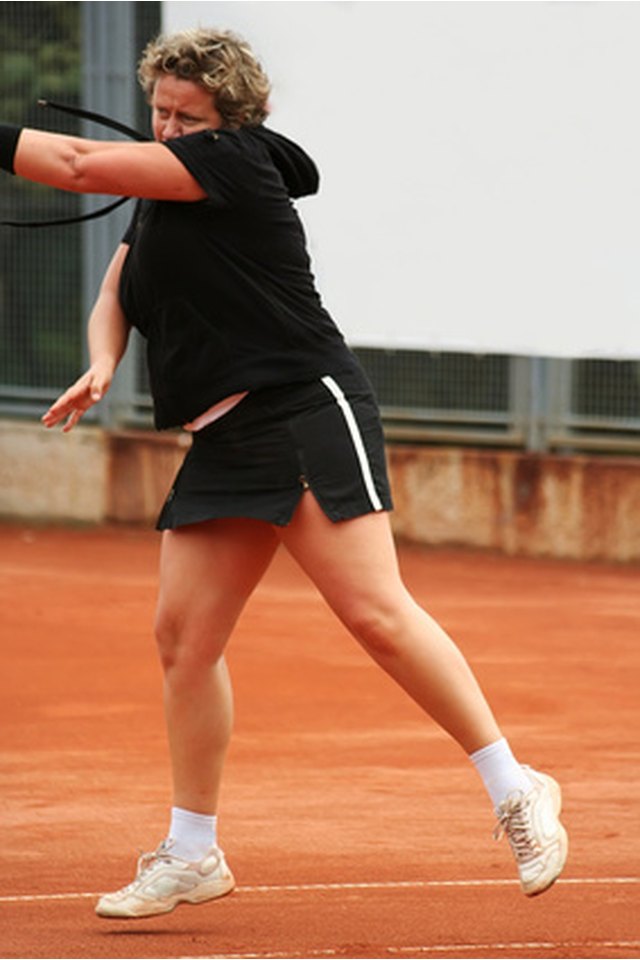Tennis Round Robin Rules

A tennis round robin is an scheduling format that guarantee players the opportunity to play more than one match when they enter an event. The format is used for competitive tournaments as well as social gatherings. If you participate in a round robin, it’s important to learn the rules of the rotation so you play with the correct partner, on the correct court and against the correct opponent.
Round Robin
A round robin, used for many sporting competitions, requires players in specific groups, such as by age, gender or skill level, to play each other over the course of several or more matches. This differs from a single-elimination event, where you are out as soon as you lose one match. In a round robin, you can lose to an opponent and still win the event if you end up with a better record than that player or team. Recreational round robins might be less strict about player matchups, pairing juniors against adults or putting three men and one woman on a court for a round. A round robin can take place in one day, over the course of a weekend or last for a season of weeks or months.
Recreational Format Rotation
A key feature of recreational round robins is the rotation of the players after each match. Many park districts, clubs or groups of friends organize doubles round robins comprised of short sets, or for short time periods, over the course of one or two hours. After each round, players change courts and play with a new partner, or with the same partner, against new opponents. Some round robins use a King/Queen of the Court format, with players moving up one court if they win a round, and down one court if they lose the round. Some round robins use a mathematical formula to rotate partners, and you will know all of your partners, opponents and court assignments in advance.
Partners
Learn if your round robin will use a fixed-partner schedule for each round or if you’ll change partners each time. Many recreational King/Queen of the Court formats require partners to split up and play against each other after each round when they move to their next court. In a fixed-partner round robin, you will play with the same partner for the entire event.
Pool Play
In competitive events with a large number of players, the competition might be divided into pool play. For example, in an event with 16 singles players, the organizers might create four pools of four players each. Each player will play the other three players in his pool. The winner of each pool will move to a playoff of the four pool winners.
Scoring
Competitive round robins use a scoring system that ensures everyone plays the same type of match, which could include best-of-three sets or a single Pro Set, which is an extended set played to eight or 10 games. In recreational round robins, players might play for a specific time, with whoever is leading when time is called the winner. Another format requires each player to serve twice in a doubles round robin, with a short tiebreak if they get to four games all. Other round robin formats include single sets, the use of no-ad scoring and rounds consisting of a tiebreak or tiebreaks. The goal of many recreational round robins is to have most players finish about the same time so everyone can rotate frequently and meet more people.
Software and Even Sheets
Mathematicians have devised a number of round robin formulas you can purchase or download free from the Internet to help you organize a round robin. Using a standard round robin sheet, you start by choosing what type of format you want, such as fixed partners, mixed doubles or singles. You choose a sheet with the number of players, courts and rounds you have, assign each of your players or teams a number and hand out the sheets or assign players their positions each round. Several software makers sell programs that let you quickly create custom round robins, or offer a service that lets you give the company your information so that they can create your round robin program. If you want a custom round robin, you enter data into a software program including the number of players you have, number of courts, number of rounds you want and format. You can request that players play with every participant once or request some other parameter. You will be limited as to your format choices based on the number of players, rounds and courts you have.
References
Writer Bio
Sam Ashe-Edmunds has been writing and lecturing for decades. He has worked in the corporate and nonprofit arenas as a C-Suite executive, serving on several nonprofit boards. He is an internationally traveled sport science writer and lecturer. He has been published in print publications such as Entrepreneur, Tennis, SI for Kids, Chicago Tribune, Sacramento Bee, and on websites such Smart-Healthy-Living.net, SmartyCents and Youthletic. Edmunds has a bachelor's degree in journalism.
